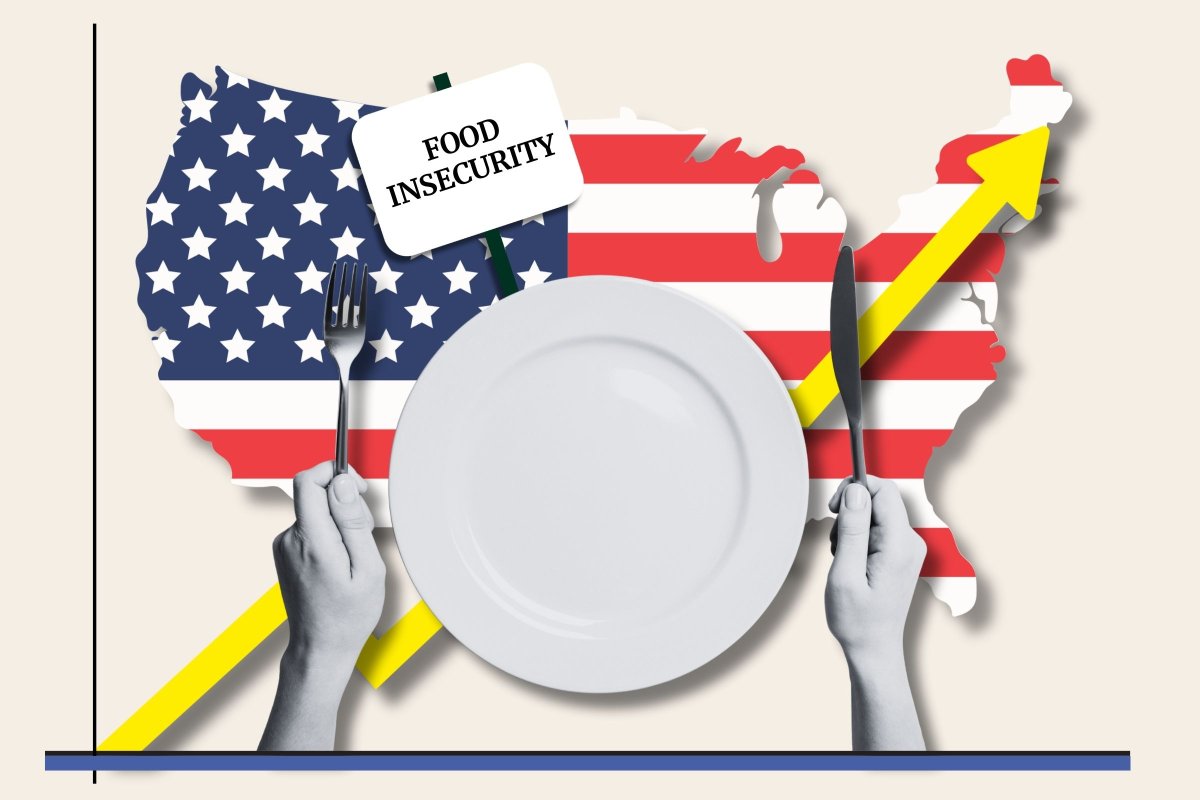The U.S. had the highest rate of people struggling to afford enough food to feed themselves and their families of all G7 countries in 2023, according to a recent Gallup survey.
One in four (26 percent) Americans surveyed in a new Gallup analysis, titled "U.S.: Leader or Loser in the G7?", said there have been times in the past 12 months when they did not have enough money to buy the food they needed.
In Canada, the rate of residents struggling to afford food within the same timeframe was 17 percent, while in France it went down to 15 percent and in Italy 14 percent. Some 13 percent of Germans were unable to afford enough food at times last year, against 9 percent in the United Kingdom and 8 percent in Japan.
While the U.S. has consistently been at the top or tied at the top of the G7 for inability to afford food at times every year since 2009, the 2023 data shows that the number of struggling Americans is growing.

"Inability to afford food has never been higher in the U.S. than it was in 2023, since Gallup started tracking this measure in 2006," Benedict Vigers, a global analytics consultant at Gallup, told Newsweek. "This figure comes amid a backdrop of recent food price inflation in the U.S., which increased sharply in 2022 and remained high last year," he added.
The results of the Gallup survey are based on telephone and web interviews made throughout 2023 with random samples of 1,000 adults aged 15 and older living in each of the seven countries in the G7.
"Our nation is facing a hunger crisis," Kelly Horton, interim president of the Food Research & Action Center (FRAC), told Newsweek. "Even as one of the wealthiest nations in the world, about 44.2 million people live in households that struggle with hunger."
According to the United States Department of Agriculture's (USDA) latest report on household food security, 12.8 percent of households—about 17 million—were food insecure in 2022, which means they had difficulties at some time during the year providing enough food for all their family members due to a lack of resources.
Hunger rates are disproportionately worse for households with children and of color, single-parent households, and those located in southern and rural areas.
According to the USDA 2022 report, food insecurity was worse among all households with children (17.3 percent of which were food insecure); households with children under the age of 6 (16.7 percent); households with children with a single mom (33.1 percent) and a single dad (21.2 percent); women living alone (15.1 percent); households headed by a Black, non-Hispanic (22.4 percent) or Hispanic (20.8 percent) adult; households with incomes below 100 percent of the poverty threshold (36.7 percent), 130 percent of the poverty threshold (35.2 percent), and 185 percent of the poverty threshold (32.0 percent); and households in principal cities (15.3 percent) and nonmetropolitan areas (rural; 14.7 percent).
The number of Americans struggling to afford enough food has been growing in recent years, a spokesperson for the USDA told Newsweek. In 2022, it was significantly higher than in 2021, when it had a prevalence of 10.2 percent, and the food insecurity rate reported from 2017 (11.8 percent) through 2020 (10.5 percent).
Why Americans Are Struggling To Put Food On The Table
The rise of inflation which followed the end of the pandemic and the end of the government's support for struggling families that characterized the period of the health emergency played a dramatic role in increasing food insecurity in the U.S.
"The unwinding of critical COVID-19 pandemic interventions coupled with the rising costs of food, housing, and other basic needs, have taken a toll on families," Horton told Newsweek.
"During the pandemic, lawmakers made significant investments in anti-hunger and anti-poverty programs to help stave off hunger for millions of families, but many of these interventions have expired, leaving families wondering where their next meal will come from or if they'll be able to pay their household bills," she continued.
"The 'rent eats first' and 'heat or eat' are phrases we hear all too often. The balancing act of meeting both shelter and nutrition needs is nearly impossible when so much of someone's income goes to their bills," Horton said.
"Food insecurity is a symptom of economic policies and practices that keep millions of individuals in the U.S. from accessing the food they need," Emily Engelhard, vice president of Food Security & Wellbeing Research & Insights for Feeding America, told Newsweek.
"The way that food security level changes coincided with a buildup and then dismantling of more robust nutrition and financial support programs suggests such policies and programs are effective in helping people during times of crisis."
Hunger levels would be much worse in the U.S. without federal nutrition programs like the Supplemental Nutrition Assistance Program (SNAP), according to Horton.
"SNAP helps tens of millions of households put food on the table," she said. "The Special Supplemental Nutrition Assistance Program for Women, Infants, and Children provides more than 6.6 million pregnant women, new mothers, infants, and children up to age five with nutritious foods and nutrition education and improves access to health care."
But as effective as they are, these programs don't impact the root causes of hunger in America. "They alone cannot end hunger when employment and wages fall short, growth is not shared equitably, and people lack access to affordable housing, health care, and sufficient disability benefits," Horton said.
Ending hunger in America is "not a national priority," Horton said. While she said that the Biden administration has done "an excellent job" supporting programs like SNAP, WIC and school meals, "it's going to take a presidential administration, Congress, and a wide array of diverse stakeholders, to catch up with other wealthier countries that have made progress in eradicating hunger and food insecurity," she said.
Are you struggling with food insecurity? Tell us your experience by contacting g.carbonaro@newsweek.com
Uncommon Knowledge
Newsweek is committed to challenging conventional wisdom and finding connections in the search for common ground.
Newsweek is committed to challenging conventional wisdom and finding connections in the search for common ground.
About the writer
Giulia Carbonaro is a Newsweek Reporter based in London, U.K. Her focus is on U.S. and European politics, global affairs ... Read more
To read how Newsweek uses AI as a newsroom tool, Click here.








